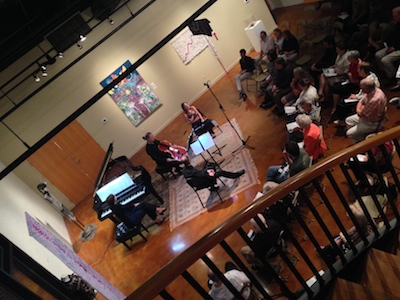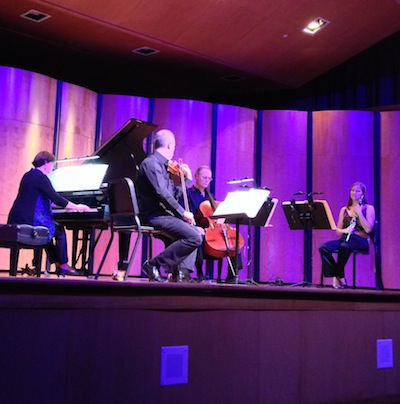

SOLI Chamber Ensemble
The end of time, and fellow travelers
October 17, 2013The American composer Paul Moravec, asked to write a short work for the San Antonio-based SOLI Chamber Ensemble’s 20th anniversary, responded with a sort of Dagwood canapé, a mere four minutes in duration but stacked sky-high with a fridgeful of ideas, textures, colors and rhythms.
Moravec’s "SOLI Collage" for clarinet, violin, cello and piano was the remarkably filling amuse-bouche on the mostly-contemporary ensemble’s season opener, Oct. 14 in Gallery Nord and Oct. 15 in Trinity University’s Ruth Taylor Recital Hall. The major work was Olivier Messiaen’s "Quartet for the End of Time," an echo of the ensemble’s first concert in 1994. Preceding the Messaien was Robert X. Rodriguez’s delicious "Musica, por un tiempo," a 2008 SOLI commission.


Members
of SOLI speak with audience at Gallery Nord.
 Clarinetist Stephanie Key, then fresh out of
the New England Conservatory, established SOLI in
1994 with San Antonio Symphony cellist David Mollenauer
(they have since married, and she has since joined the
orchestra). After a few early changes in personnel,
their partners since 2000 have been violinist Ertan
Torgul, associate concertmaster of the San Antonio
Symphony until he resigned last year, and pianist Carolyn
True, who teaches at Trinity University. Although the
troupe occasionally dips into the 19th and 18th centuries,
most of its programming is contemporary. It has
commissioned or co-commissioned several dozen works.
Clarinetist Stephanie Key, then fresh out of
the New England Conservatory, established SOLI in
1994 with San Antonio Symphony cellist David Mollenauer
(they have since married, and she has since joined the
orchestra). After a few early changes in personnel,
their partners since 2000 have been violinist Ertan
Torgul, associate concertmaster of the San Antonio
Symphony until he resigned last year, and pianist Carolyn
True, who teaches at Trinity University. Although the
troupe occasionally dips into the 19th and 18th centuries,
most of its programming is contemporary. It has
commissioned or co-commissioned several dozen works.San Antonio is in the midst of a Moravec binge. Early last year SOLI gave the premiere of his brief "Grosse Fuge Fantasy," one of four commissioned works drawing on ideas from Beethoven’s astonishing quartet movement. (It is not for nothing that SOLI won a 2013 Chamber Music America/ASCAP award for adventurous programming.) The troupe is negotiating with Moravec for a third, longer work. Last year Moravec created a tremendously difficult new work, "Upsparkles," for the San Antonio International Piano Competition.
Although his "SOLI Collage" is not programmatic, its structure does suggest a narrative. It begins with a dense, intricately detailed, inchoate cloud that laboriously ascends, then suddenly swoops downward, giving way to a giddily accelerating chase scene. The texture thins, the colors become somewhat ominous, and the cloud returns briefly, but then Moravec leaps to the opposite pole with a concluding passage of chordal homophony, foursquare in its directness.
What does it all mean? Only that Moravec possesses a unique ability to surprise, to delight, to provoke, and, in the densely textured passages, to fill every inch of sonic space with intriguing squiggles.
 years, is a prolific, widely performed composer of operas
("Frida," commissioned by the American Music Theater
Festival, made the biggest splash) and orchestral and
chamber music. His work was heard most recently in New
York in a recital dedicated solely to his work by pianist
Jeff Lankov. His music tends to be witty and movingly
lyrical by turns, frequently steals (his term) thematic
material from the past, and is often very intricate in
construction.
years, is a prolific, widely performed composer of operas
("Frida," commissioned by the American Music Theater
Festival, made the biggest splash) and orchestral and
chamber music. His work was heard most recently in New
York in a recital dedicated solely to his work by pianist
Jeff Lankov. His music tends to be witty and movingly
lyrical by turns, frequently steals (his term) thematic
material from the past, and is often very intricate in
construction. The very title of Rodriguez’s "Musica, por un tiempo" exemplifies how his compositional mind works -- slightly daft, much more than slightly deft, and overflowing with references. The title refers in part to Henry Purcell’s "Music for a While," whose ground bass provides the new work’s thematic spine, though the line appears in recognizable form only briefly. The work was commissioned as a companion piece to Messiaen’s Quartet, so “tiempo” also alludes to that. The Spanish rendering reflects Rodriguez’s elaboration and deconstruction of of Purcell’s bass line into a rumba, often with a high degree of contrapuntal complexity. The three movements are played without pause. The outer two are rollicking, the central one tender, erotic and meltingly lovely.
The two performances of Messiaen’s Quartet were strikingly dissimilar. In Gallery Nord, an art space with a very airy and fat acoustic, clarinetist (and artistic director) Stephanie Key’s birdsong in the opening movement was playful; in Ruth Taylor Recital Hall, with a more-focused acoustic, she played the same passages more pensively. In the fifth movement, “Praise to the eternity of Jesus,” David Mollenauer’s limpid cello tone expanded to envelop the listeners in Gallery Nord, but he played more deeply and beautifully in Ruth Taylor. The sixth movement, “Dance of fury for the seven trumpets,” was swingy in Gallery Nord, much more strict rhythmically in Ruth Taylor. Violinist Ertan Torgul’s account of the closing “Praise to the immortality of Jesus” was outgoing and rhetorical in Gallery Nord, more inward and controlled in Ruth Taylor. Only pianist Carolyn True, consistently vigorous and precise, seemed immune to the differences in the venues.
One difference in the two performances was visual: SOLI took advantage of Ruth Taylor’s newly installed LED lighting to vary the hue of the stage lighting for each movement of the Messiaen Quartet.
Key, buttonholed after the Ruth Taylor concert, attributed the performance differences partly to acoustics and partly to proximity: The intimate gallery space brought the audience closer to, and on the same level as, the musicians, who consequently felt greater comfort and interpretive freedom.
Her comments serve as a reminder that acoustics is not just a matter of physics, but of psychology as well. Musicians are, among other things, human.
Mike Greenberg
Here's video of SOLI’s 2009 premiere performance of Robert X. Rodriguez’s "Musica, por un tiempo," in Ruth Taylor Recital Hall
SOLI playing Messiaen's "Quartet for the End of Time" at Ruth Taylor Recital Hall